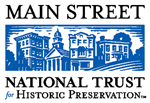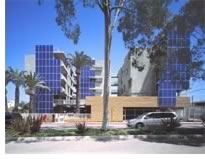

AIA eClassroom Offers
Four New Distance-Ed Courses
From Main Street to green building, they
teach why design
(and getting paid) matter
AIA eClassroom has just added four new practice-oriented distance learning programs to its repertoire of continuing education classes for architects. These courses are derived from the highest-rated continuing-ed programs held at the 2003 AIA national convention in San Diego.
 TH06
Main Street, the Architect, and Downtown Revitalization
TH06
Main Street, the Architect, and Downtown Revitalization
Learn how new financial and zoning tools are creating opportunities for
profitable investment in commercial districts. This course examines the
Main Street program; revitalization loans, grants, and tax credits; new
codes and regulations that encourage adaptive reuse; and two buildings
where these tools have been used. Specifically, participants will learn
about:
- The Main Street program and tenets
- The economics of historic preservation
- New building codes that reduce costs when rehabilitating existing/historic structures
- Financial incentives for downtown revitalization and historic preservation
- How these tools were used to rehabilitate the 1937 Martin County Courthouse and the 1925 Post Office Arcade, both in Stuart, Fla.
Community development specialist Joan Jefferson teaches this course.
She is a Main Street consultant for the Florida Department of Historic
Preservation and the former mayor of Stuart, Fla., and was a Stuart City
commissioner for nine years. Learn more about this course. ![]()
 TH16
Green Matters: LEED™ as an Integrated Design Tool
TH16
Green Matters: LEED™ as an Integrated Design Tool
This course highlights three case studies with typical programs and budgets
in which LEED™ was used to create holistic, sustainable, and award-winning
projects. They dispel the myth that “green buildings cost more and
are only for special-purpose programs.” This course will teach you
to:
- Institutionalize sustainable design in an architecture practice
- Be able to integrate a “green” consultant into the design process at the very beginning of a project.
Dan Heinfeld, FAIA, president, LPA, Inc., partner-in-charge of design
for the company since 1986, serves as one of the course instructors. Under
his direction, LPA was selected as the 1990 AIACC Firm of the Year. Heinfeld
partners with Malcolm Lewis, PhD, PE, president, CTG Energetics Inc.,
who has been active in the design of leading-edge buildings for more than
30 years as a consulting engineer specializing in mechanical, electrical,
and energy systems. Learn more about this course. ![]()
 TH32
How to Build Green Without Going in the Red
TH32
How to Build Green Without Going in the Red
This course explores the case study of the 2003 AIA Honor Award-winning
Colorado Court, a 44-unit apartment building in Santa Monica that incorporates
good design, passive and active environmental systems, and affordability.
This course will allow you to:
- Identify sustainable systems/building materials and their cost and apply this knowledge to an actual project with a budget
- Mitigate potential problems inherent in building with sustainable systems/materials that are new or infrequently used
- Weigh the advantages of various sustainable systems in terms of life-cycle cost and gain a general idea of where to obtain funding for some of these systems/materials.
Your instructor for this course is Angela Brooks, Assoc. AIA, Pugh Scarpa
Kodama, the architect for Colorado Court. She is a LEED™-accredited
consultant who has worked with the Los Angeles Community Design Center,
a private, nonprofit development company dedicated to building affordable
housing and creating stable neighborhoods. Learn more about this course.
![]()
SA26 Design Matters and Being Paid for
Design Matters
Reviewing legal and business status, contractual language, public
and private clients, retainers, work performance, effective invoices,
client viability, client bankruptcy, case studies, debt collection, and
communication methods with the goal of prompt payment, you will learn:
- What it takes to charge for architectural services legally
- To assess clients and project viability before accepting a project
- Techniques of invoicing, coordinating contracts with invoices, and practical methods of collecting payments.
Course instructors William Manion, AIA, and Sara P. O’Neil-Manion,
AIA, are principals of O’Neil & Manion Architects P.A., a firm
that has been recognized with many national and local design awards in
a variety of project types. Manion has been an undergraduate instructor
at the Catholic University School of Architecture, a guest lecturer for
both the Catholic University and George Washington University, and an
expert witness on both real estate and construction cases. O’Neil-Manion
has been an undergraduate and graduate instructor at the Catholic University
School of Architecture and has been an expert witness on construction
litigation cases. Learn more about this course. ![]()
Copyright 2003 The American Institute of Architects.
All rights reserved. Home Page ![]()
![]()
